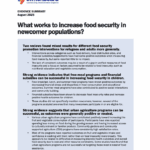Purpose of Review To synthesise the research which has sought to evaluate interventions aiming to tackle children’s food insecurity and the contribution of this research to evidencing the effectiveness of such interventions. Recent Findings The majority of studies in this review were quantitative, non-randomised studies, including cohort studies. Issues with non-complete outcome data, measurement of duration of participation in interventions, and accounting for confounds are common in these evaluation studies. Despite the limitations of the current evidence base, the papers that were reviewed provide evidence for multiple positive outcomes for children participating in attended and subsidy interventions, inter alia, reductions in food insecurity, poor health and obesity. However, current evaluations may overlook key areas of impact of these interventions on the lives and outcomes of participating children. Summary This review suggests that the current evidence base which evaluates food insecurity interventions for children is both mixed and limited in scope and quality. In particular, the outcomes measured are narrow, and many papers have methodological limitations. With this in mind, a systems-based approach to both implementation and evaluation of food poverty interventions is recommended.
The management of volunteers – What can human resources do? A review and research agenda
There is an increasing interest from scholars and practitioners in understanding how non-profit organizations can design and implement human resources (HR) practices to enhance desirable volunteer attitudes and behaviors. This paper presents a comprehensive overview of existing studies on the relationship between HR practices and volunteering outcomes. We use the ability-motivation-opportunity model as a guiding…

